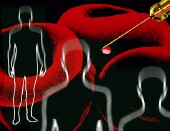
WEDNESDAY, March 16 (HealthDay News) — A lower dose of the drug cytarabine work as well as the high doses that are typically used to treat acute myeloid leukemia, and with fewer side effects, a new Dutch study finds.
Cytarabine is used in the treatment of acute myeloid leukemia (AML), along with other chemotherapy drugs and stem cell transplantation. Cytarabine resembles a normal cell nutrient needed by cancer cells to grow. However, when these cells take up cytarabine, the drug actually interferes with their growth.
“The high-dose cytarabine schedules represent an unnecessary overdose causing excess toxicity with no apparent clinical benefit,” said lead researcher Dr. Bob Lowenberg, a professor of hematology at Erasmus University Medical Center in Rotterdam. “The lower dose level is sufficient.”
The report is published in the March 17 issue of the New England Journal of Medicine.
For the study, Lowenberg’s team compared two different intravenous doses of cytarabine in patients with AML. One group of 431 patients was given a lower dose of the drug, while 429 were given a high dose, which is the current standard dose.
Patients who had a complete response to the drug after the first two cycles were taken off the drug, and treatment continued with another type of chemotherapy or a stem cell implant.
Over five years of follow-up, the researchers found no difference between the two groups in terms of remission. Eighty percent of those who received the lower dose had a complete remission, as did 82 percent of those who were given the higher dose.
There was also no significant difference in probability of relapse (34 percent of those given the lower dose and 35 percent of those who received the higher dose), or in overall survival (40 percent in the lower-dose group and 42 percent in the high-dose group).
Not only that, but patients receiving the high doses were more likely to suffer side effects than those given the lower doses, the researchers added. These included skin reactions and gastrointestinal and ocular toxic effects. Also, those given the high dose had longer hospital stays and delays in the recovery of white blood cells and platelets.
“The current standard of treatment with high-dose cytarabine, one of the major chemotherapeutic agents applied in the treatment of acute myeloid leukemia, represents an overdose,” Lowenberg said.
One-tenth of the standard dose produces equally effective treatment, but with less toxicity, shorter hospital stays and fewer transfusions, he added.
“The lower-dose level also involves reduced costs,” Lowenberg said. “These results set a new standard of care for the therapy of acute myeloid leukemia.”
Dr. Mark H. Kirschbaum, an associate member for malignant hematology at the Nevada Cancer Institute in Las Vegas, said that “this is a very important study that will likely impact upon the treatment of patients with acute myeloid leukemia, particularly the older patient population, who clinically have always seemed to suffer from significant toxicity with higher-dose regimens.”
“Hopefully progress in the molecular therapeutics of leukemia will allow us to more safely treat patients, particularly the older patients who make up the large majority of new AML patients, in a less toxic manner,” he said.
More information
For more information on acute myeloid leukemia, visit the Leukemia & Lymphoma Society.

